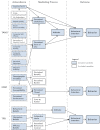Development of a health information technology acceptance model using consumers' health behavior intention
- PMID: 23026508
- PMCID: PMC3510715
- DOI: 10.2196/jmir.2143
Development of a health information technology acceptance model using consumers' health behavior intention
Abstract
Background: For effective health promotion using health information technology (HIT), it is mandatory that health consumers have the behavioral intention to measure, store, and manage their own health data. Understanding health consumers' intention and behavior is needed to develop and implement effective and efficient strategies.
Objective: To develop and verify the extended Technology Acceptance Model (TAM) in health care by describing health consumers' behavioral intention of using HIT.
Methods: This study used a cross-sectional descriptive correlational design. We extended TAM by adding more antecedents and mediating variables to enhance the model's explanatory power and to make it more applicable to health consumers' behavioral intention. Additional antecedents and mediating variables were added to the hypothetical model, based on their theoretical relevance, from the Health Belief Model and theory of planned behavior, along with the TAM. We undertook structural equation analysis to examine the specific nature of the relationship involved in understanding consumers' use of HIT. Study participants were 728 members recruited from three Internet health portals in Korea. Data were collected by a Web-based survey using a structured self-administered questionnaire.
Results: The overall fitness indices for the model developed in this study indicated an acceptable fit of the model. All path coefficients were statistically significant. This study showed that perceived threat, perceived usefulness, and perceived ease of use significantly affected health consumers' attitude and behavioral intention. Health consumers' health status, health belief and concerns, subjective norm, HIT characteristics, and HIT self-efficacy had a strong indirect impact on attitude and behavioral intention through the mediators of perceived threat, perceived usefulness, and perceived ease of use.
Conclusions: An extended TAM in the HIT arena was found to be valid to describe health consumers' behavioral intention. We categorized the concepts in the extended TAM into 3 domains: health zone, information zone, and technology zone.
Conflict of interest statement
None declared.
Figures



References
-
- Thompson TG, Brailer DJ. The Decade of Health Informaton Technology: Delivering Consumer-Centric and informaton-Rich Health Care: Framework for Strategic Action. Washington, DC: US Department of Health and Human Services; 2004. Jul 21, [2012-09-26]. 6AxzYlVuB http://www.providersedge.com/ehdocs/ehr_articles/the_decade_of_hit-deliv....
-
- Wikipedia. 2012. May 16, Health Information Technology http://en.wikipedia.org/wiki/Health_information_technology.
-
- Pivovarov R, Crawford M, Kos P, Patil P, Tonellato P. F1000Posters. 2012. Clinical Avatars for Breast Cancer Risk Prediction Creation and Preliminary Bayesian Network Simulations http://f1000.com/posters/browse/summary/401.
-
- Greene K. Technology Review, Massachusetts Institute of Technology. 2008. Sep 10, [2012-04-24]. Self Surveillance: A New Device Tracks Activity and Sleep Patterns 24-7 http://www.technologyreview.com/communications/21361/page1/
-
- Glantz K, Maddock J. eNotes.com. 2010. Encyclopedia of Public Health: Behavior, Health-Related http://www.enotes.com/public-health-encyclopedia/behavior-health-related.
Publication types
MeSH terms
LinkOut - more resources
Full Text Sources

